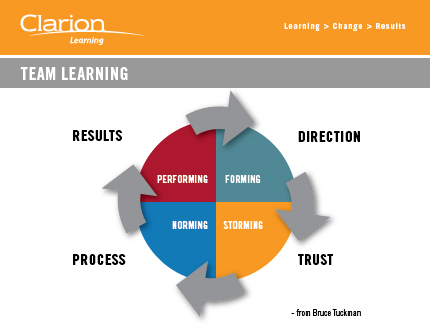Team Learning
'If we are to enjoy the efficiencies and other benefits of the virtual organisation, we will have to discover how to run organisations more on trust than on control. Virtuality requires trust to make it work; technology on its own is not enough.' - Charles Handy
Team learning events at Clarion Learning can be designed and developed for any team in any situation; however we specialize in working with virtual and cross-functional teams operating within a global matrix organization. Collaboration between groups and individuals working remotely is not a new concept. However the development of information technology has driven the development of virtual teams. In today's global market place, organizations looking for a competitive edge have found it in technology which allows them to utilize employees in new ways; in different places at different times. Reduced social interaction, working in different time-zones, limited informal communication and cultural differences make the task of building an effective virtual team extremely challenging.
We are convinced of the validity of the model of group development proposed by Bruce Tuckman which suggests that there is a developmental sequence which all groups go through during their active life-cycle. Team learning therefore begins by assessing the current stage of development. We then design a learning intervention that facilitates a shift to the next stage. Tuckman proposed four phases - forming, storming, norming and performing.

forming
Teams that enter the initial phase of development will generally be attempting to establish (directly or indirectly) their common purpose and how the individuals that make the team will cooperate with each other to achieve the agreed objectives. People are often friendly and polite but true feelings and strong opinions may well be withheld and difficult issues are often avoided. The team is often looking to the leader for clear guidance and agreements can often be reached quickly but without a strong sense of commitment.
The best strategy at this stage is often to invest time in relationships without losing sight of task issues and so enable the team to move forward more quickly through the storming and norming phases and achieve the desired business results.
storming
Once teams have established their common purpose and team members have identified the tasks that need to be addressed, a team dynamic - often referred to as storming - usually occurs. People often begin challenging one another (either directly or indirectly) in an attempt to clarify the way in which goals are achieved and the roles and responsibilities of the individuals involved. If this dynamic is not experienced as a positive and constructive process, it leads to withdrawal or confrontation by team members and competition rather than team collaboration.
The best strategy at this stage is often to invest time building trust and exploring individual differences with the goal of exploiting those differences to increase creativity and innovation and achieve the desired business results.
norming
Teams that have clearly defined goals, individual roles and responsibilities and agreed upon processes often start to experience powerful dynamic of coming together. A strong sense of team spirit and identity starts to emerge and challenging problems and tasks can be addressed and managed. The challenge here is often to integrate new team members, create changes in the team's structures and mindsets and reach improved levels of individual and team performance - put simply the team can become a victim of its own success and struggle to move to the next level.
The best strategy at this stage is to have the team identify standards of excellence that should be maintained while accepting and recognizing that each individual team member has their own strengths and talents that can contribute to achieving team goals.
performing
This team has high levels of trust, unity and commitment and is achieving results. There is a high level of interdependence, respect and loyalty between team members. Roles and responsibilities have become more fluid and dynamic. The leadership role, in particular, shifts between team members depending on the context.
The best strategy for a team leader at this stage is to delegate tasks wherever possible, encourage the personal development of team members and stay out of the way!
For more information contact us